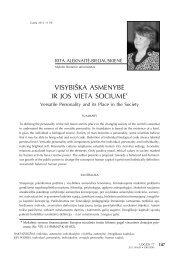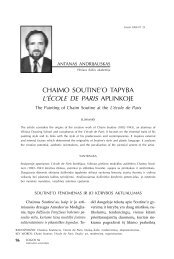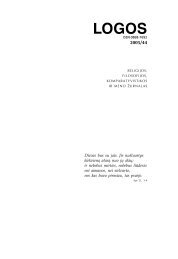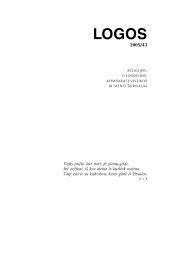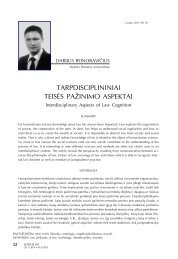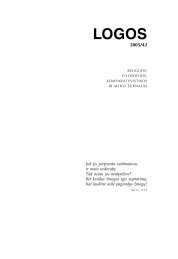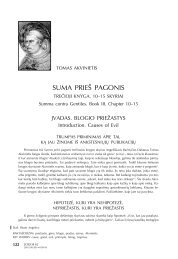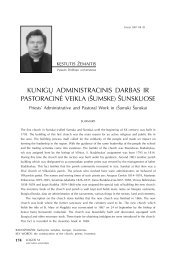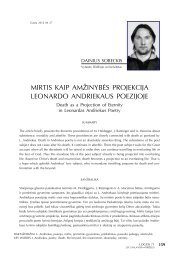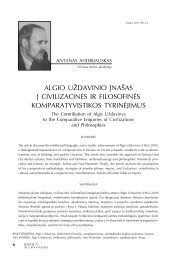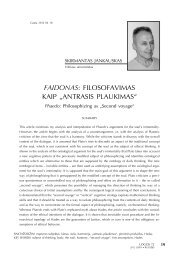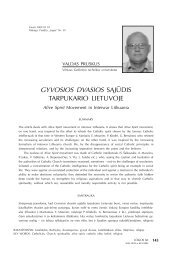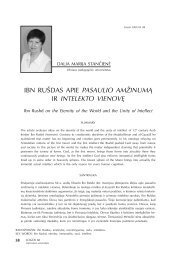Argi papirusas gali augti ten, kur nėra pelkių? Argi nendrės ... - Logos
Argi papirusas gali augti ten, kur nėra pelkių? Argi nendrės ... - Logos
Argi papirusas gali augti ten, kur nėra pelkių? Argi nendrės ... - Logos
You also want an ePaper? Increase the reach of your titles
YUMPU automatically turns print PDFs into web optimized ePapers that Google loves.
Gauta 2002-02-10<br />
Tæsinys. Pradþia „<strong>Logos</strong>“ Nr. 31, 32<br />
AUDRIUS BEINORIUS<br />
Kultûros, filosofijos ir meno institutas<br />
MOKSLINË MINTIS<br />
ÞODÞIO (VÂC) TEOLOGIJA RELIGINËJE<br />
INDIJOS KULTÛROJE<br />
The Theology of the Word (vâc) in Indian<br />
Religious Culture<br />
SUMMARY<br />
The climax of a hermeneutics of synthesis and the sacred Verbum exegesis is represented in Tantric<br />
Kashmiri tradition and mainly in Abhinavagupta’s works. In his Parâtrîúikâ Vivaraa, one of the most<br />
fascinating but also most difficult mystical texts of the Kashmir Úaiva philosophy dealing with the theory<br />
and practice of mantra, Abhinavagupta presents a penetrating metaphysics of language and its various<br />
stages in relation to consciousness.<br />
The 50 letters of the Sanskrit alphabet, which are the smallest phonemic units into which speech<br />
can be analysed, are a symbolic expression of the principal elements of the activity of consciousness.<br />
While the Vedic mantras are comprised of complete sen<strong>ten</strong>ces, the Tantric mantras are in the form of<br />
monosyllabic vocables only, technically called the bîjamantras, in theory, are sonic manifestations of<br />
basic cosmic powers. The most interesting example of the association of the Sanskrit alphabet (varamâlâ)<br />
with the cosmology and activity of consciousness is Abhinavagupta’s esoteric exegesis of the symbolic<br />
significance of the mantra A h a ˜, which in Sanskrit means ‘I’ and symbolises by its form the dynamic<br />
nature of the Self. The mantric utterance gets singled out as the one form of discource that enables a<br />
human being to assert, to recognize (pratyabhijñâ) his freedom within the cosmic process by identifying<br />
himself with Úiva. The right mantra used in the proper way by a qualified person is believed to be a<br />
key that unlocks the Úaktic structure of the cosmos. Abhinavagupta’s subtle speculation on the Word<br />
ex<strong>ten</strong>ds from its mystical dimension to the intricacies of the Sanskrit alphabet and linguistic speculation,<br />
from psychological subtleties to philosophical reasoning.<br />
RAKTAÞODÞIAI. Hinduizmas, tantrinë teologija, lingvistinë indø tradicija, religijotyra.<br />
KEY WORDS. Hinduism, Tantric theology, Indian linguistic tradition, comparative religious studies.<br />
LOGOS 34<br />
2003 LIEPA • RUGSËJIS<br />
123



